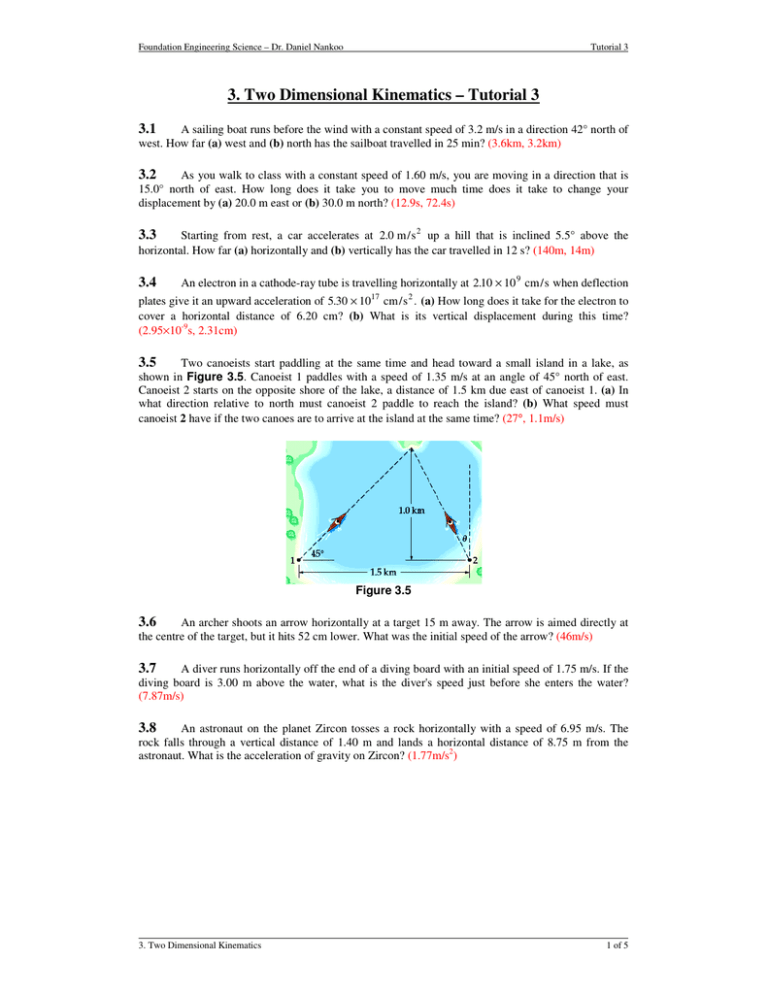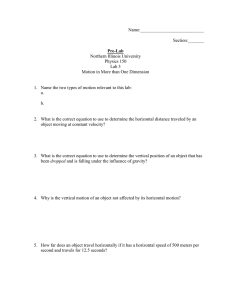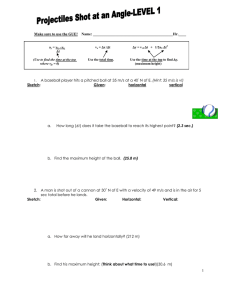3. Two Dimensional Kinematics – Tutorial 3
advertisement

Foundation Engineering Science – Dr. Daniel Nankoo Tutorial 3 3. Two Dimensional Kinematics – Tutorial 3 3.1 A sailing boat runs before the wind with a constant speed of 3.2 m/s in a direction 42° north of west. How far (a) west and (b) north has the sailboat travelled in 25 min? (3.6km, 3.2km) 3.2 As you walk to class with a constant speed of 1.60 m/s, you are moving in a direction that is 15.0° north of east. How long does it take you to move much time does it take to change your displacement by (a) 20.0 m east or (b) 30.0 m north? (12.9s, 72.4s) Starting from rest, a car accelerates at 2.0 m/s 2 up a hill that is inclined 5.5° above the horizontal. How far (a) horizontally and (b) vertically has the car travelled in 12 s? (140m, 14m) 3.3 3.4 An electron in a cathode-ray tube is travelling horizontally at 2.10 × 10 9 cm/s when deflection plates give it an upward acceleration of 5.30 × 1017 cm/s 2 . (a) How long does it take for the electron to cover a horizontal distance of 6.20 cm? (b) What is its vertical displacement during this time? (2.95×10-9s, 2.31cm) 3.5 Two canoeists start paddling at the same time and head toward a small island in a lake, as shown in Figure 3.5. Canoeist 1 paddles with a speed of 1.35 m/s at an angle of 45° north of east. Canoeist 2 starts on the opposite shore of the lake, a distance of 1.5 km due east of canoeist 1. (a) In what direction relative to north must canoeist 2 paddle to reach the island? (b) What speed must canoeist 2 have if the two canoes are to arrive at the island at the same time? (27°, 1.1m/s) Figure 3.5 3.6 An archer shoots an arrow horizontally at a target 15 m away. The arrow is aimed directly at the centre of the target, but it hits 52 cm lower. What was the initial speed of the arrow? (46m/s) 3.7 A diver runs horizontally off the end of a diving board with an initial speed of 1.75 m/s. If the diving board is 3.00 m above the water, what is the diver's speed just before she enters the water? (7.87m/s) 3.8 An astronaut on the planet Zircon tosses a rock horizontally with a speed of 6.95 m/s. The rock falls through a vertical distance of 1.40 m and lands a horizontal distance of 8.75 m from the astronaut. What is the acceleration of gravity on Zircon? (1.77m/s2) 3. Two Dimensional Kinematics 1 of 5 Foundation Engineering Science – Dr. Daniel Nankoo Tutorial 3 3.9 A crow is flying horizontally with a constant speed of 2.70 m/s when it releases a clam from its beak (Figure 3.9). The clam lands on the rocky beach 2.10 s later. Just before the clam lands, what is (a) its horizontal component of velocity, and (b) its vertical component of velocity? (c) How would your answers to parts (a) and (b) change if the speed of the crow were increased? Explain. (2.70m/s, 20.6m/s) Figure 3.9 3.10 A mountain climber jumps a 2.8-m wide crevasse by leaping horizontally with a speed of 7.8 m/s. (a) If the climber's direction of motion on landing is −45º , what is the height difference between the two sides of the crevasse? (b) Where does the climber land? (3.1m, 3.4m) 3.11 A white-crowned sparrow flying horizontally with a speed of 1.80 m/s folds its wings and begins to drop in free fall. (a) How far does the sparrow fall after travelling a horizontal distance of 0.500 m? (b) If the sparrow's initial speed is increased, does the distance of fall increase, decrease, or stay the same? (0.378m) 3.12 In Denver, children bring their old jack-o-lanterns to the top of a tower and compete for accuracy in hitting a target on the ground (Figure 3.12). Suppose that the tower is 9.0 m high and that the bull's-eye is a horizontal distance of 3.5 m from the launch point. If the pumpkin is thrown horizontally, what is the launch speed needed to hit the bull's-eye? (2.6m/s) Figure 3.12 3. Two Dimensional Kinematics 2 of 5 Foundation Engineering Science – Dr. Daniel Nankoo Tutorial 3 3.13 Fairgoers ride a Ferris wheel with a radius of 5.00 m (Figure 3.13). The wheel completes one revolution every 32.0 s. (a) What is the average speed of a rider on this Ferris wheel? (b) If a rider accidentally drops a stuffed animal at the top of the wheel, where does it land relative to the base of the ride? (Note: The bottom of the wheel is 1.75 m above the ground.) (0.982m/s, 1.52m) Figure 3.13 3.14 A swimmer runs horizontally off a diving board with a speed of 3.62 m/s and hits the water a horizontal distance of 1.68 m from the end of the board. (a) How high above the water was the diving board? (b) If the swimmer runs off the board with a reduced speed, does it take more, less, or the same time to reach the water? (1.06m) 3.15 A basketball is thrown horizontally with an initial speed of 4.20 m/s (Figure 3.15). A straight line drawn from the release point to the landing point makes an angle of 30.0° with the horizontal. What was the release height? (1.20m) Figure 3.15 3.16 A ball rolls off a table and falls 0.75 m to the floor, landing with a speed of 4.0 m/s. (a) What is the acceleration of the ball just before it strikes the ground? (b) What was the initial speed of the ball? (c) What initial speed must the ball have if it is to land with a speed of 5.0 m/s? (9.81m/s2 down, 1.1m/s, 3.2m/s) 3. Two Dimensional Kinematics 3 of 5 Foundation Engineering Science – Dr. Daniel Nankoo Tutorial 3 3.17 A cork shoots out of a champagne bottle at an angle of 35.0° above the horizontal. If the cork travels a horizontal distance of 1.30 m in 1.25 s, what was its initial speed? (1.04m/s, 1.27m/s) 3.18 A football is kicked with a speed of 9.50 m/s at an angle of 25.0° above the horizontal. If the ball lands at the same level from which it was kicked, how long was it in the air? (0.818s) 3.19 In a game of basketball, a forward makes a bounce pass to the centre. The ball is thrown with an initial speed of 4.3 m/s at an angle of 15° below the horizontal. It is released 0.80¤m above the floor. What horizontal distance does the ball cover before bouncing? (1.3m) 3.20 Snowballs are thrown with a speed of 13 m/s from a roof 7.0 m above the ground. Snowball A is thrown straight downward; snowball B is thrown in a direction 25° above the horizontal. (a) Is the landing speed of snowball A greater than, less than, or the same as the landing speed of snowball B? Explain. (b) Verify your answer to part (a) by calculating the landing speed of both snowballs. (18m/s, 18m/s) 3.21 A golfer gives a ball a maximum initial speed of 30.0 m/s. (a) What is the longest possible hole-in-one for this golfer? Neglect any distance the ball might roll on the green and assume that the tee and the green are at the same level. (b) What is the minimum speed of the ball during this hole-inone shot? (91.7m, 21.2m/s) 3.22 What is the highest tree the ball in the previous problem could clear on its way to the longest possible hole-in-one? (22.9m) 3.23 In a friendly game of handball, you hit the ball essentially at ground level and send it toward the wall with a speed of 14 m/s at an angle of 34° above the horizontal. (a) How long does it take for the ball to reach the wall if it is 3.8 m away? (b) How high is the ball when it hits the wall? (0.33s, 2.0m) 3.24 On a hot summer day, a young girl swings on a rope above the local swimming hole (Figure 3.24). When she lets go of the rope her initial velocity is 2.25 m/s at an angle of 35.0° above the horizontal. If she is in flight for 0.616s, how high above the water was she when she let go of the rope? (1.07m) Figure 3.24 3.25 A certain projectile is launched with an initial speed v0 . At its highest point its speed is v0 4 . What was the launch angle? (75.5°) 3.26 A dolphin jumps with an initial velocity of 12.0 m/s at an angle of 40.0° above the horizontal. The dolphin passes through the centre of a hoop before returning to the water. If the dolphin is moving horizontally when it goes through the hoop, how high above the water is the centre of the hoop? (3.03m) 3.27 A player passes a basketball to another player who catches it at the same level from which it was thrown. The initial speed of the ball is 7.1 m/s, and it travels a distance of 4.6 m. What was (a) the initial direction of the ball and (b) its time of flight? (32°, 0.76s) 3. Two Dimensional Kinematics 4 of 5 Foundation Engineering Science – Dr. Daniel Nankoo Tutorial 3 3.28 A golf ball is struck with a five iron on level ground. It lands 92.2 m away 4.30 s later. What was (a) the direction and (b) the magnitude of the initial velocity? (45.5°, 30.1m/s) 3.29 Astronomers have discovered several volcanoes on Io, a moon of Jupiter. One of them, named Loki, ejects lava to a maximum height of 2.00 × 10 5 m. (a) What is the initial speed of the lava? (The acceleration of gravity on Io is 1.80 m/s 2 . ) (b) If this volcano were on Earth, would the maximum height of the ejected lava be greater than, less than, or the same as on Io? Explain. (849m/s) 3.30 A football is kicked with an initial speed of 10.2 m/s in a direction 25.0° above the horizontal. Find the magnitude and direction of its velocity (a) 0.250 s and (b) 0.500 s after being kicked. (c) Is the ball at its greatest height before or after 0.500 s? Explain. (9.43m/s, 11.4°, 9.26m/s, -3.68°) 3.31 A second football is kicked with the same initial speed as in Problem 3.30. After 0.750 s it is at its highest point. What was its initial direction of motion? (46.2°) 3.32 A golfer tees off on level ground, giving the ball an initial speed of 42.0 m/s and an initial direction of 35.0° above the horizontal. (a) How far from the golfer does the ball land? (b) The next golfer in the group hits a ball with the same initial speed but at an angle above the horizontal that is greater than 45.0°. If the second ball travels the same horizontal distance as the first ball, what was its initial direction of motion? Explain. (169m, 55.0°) 3.33 One of the most popular events at Highland games is the hay toss, where competitors use a pitchfork to throw a bale of hay over a raised bar. Suppose the initial velocity of a bale of hay is r v = (112 . m/s)x$ + (8.85 m/s)y$ . (a) How long after the hay is tossed after what minimum time is its speed equal to 5.00 m/s? (b) How long after the hay is tossed is it moving in a direction that is 45.0° below the horizontal? (c) If the bale of hay is tossed with the same initial speed, only this time straight upward, will its time in the air increase, decrease, or stay the same? Explain. (0.405s, 1.02s) 3. Two Dimensional Kinematics 5 of 5





